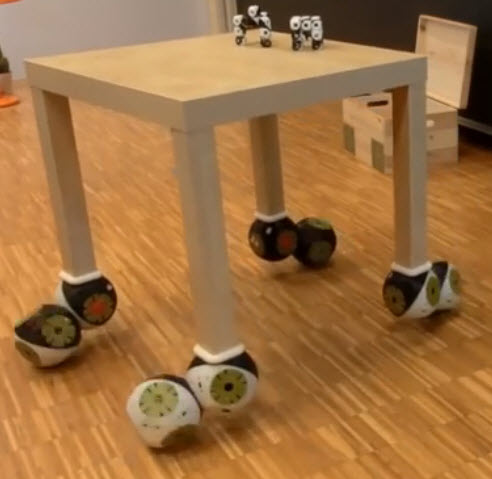‘Roombots’ transform into movable furniture and objects
May 24, 2014
EPFL scientists have developed LEGO-like adaptive robotic modules called “Roombots” that can change their shape to create reconfigurable, movable furniture and objects.
Like LEGO bricks, Roombots can be stacked upon each other to create various structures and combined with furniture and other objects, changing shape and functionality during the day as needed.
“It could be very useful for disabled individuals to be able to ask objects to come closer to them, or to move out of the way,” says Auke Ijspeert, head of the EPFL Biorobotics Laboratory (BIOROB).
Each 22 cm-long module, which looks like two large dice joined together, has a wireless connection, battery, and three motors that allow the module to pivot with three degrees of freedom.
The modules have retractable “claws” that they use to attach to other pieces to form larger structures. With a series of rotations and connections, the modules can change shape and become any of a variety of objects. A special surface with holes adapted to the Roombots’ mechanical claws allow for anchoring the modules to a wall or floor.
EPFL scientists are creating futuristic furniture that can move around and autonomously
change its shape, which may prove helpful for disabled individuals
Design students at ENSCI Les Ateliers in France have developed ideas (videos) for uses of Roombots, such as flower pots that can move from window to window around a building and modular lighting components and sound systems.
The Roombots are somewhat similar to MIT’s more complex self-assembling M-Blocks, which are programmable cube robots with no external moving parts that could be used for tasks like repairing bridges or buildings during emergencies.
The Roombots project is described in the journal Robotics and Autonomous Systems. It was co-funded by the Swiss National Centre for Competence in Research Robotics.
Abstract of Robotics and Autonomous Systems paper
- We designed, implemented, and tested the Roombots (RB) modular robots.
- We explain the RB design methodology: active connection mechanism and module.
- RB use locomotion on-grid (lattice-based environment), and off-grid locomotion.
- RB join into metamodules on-grid, and can transit from off-grid to on-grid.
- We demonstrate RB overcoming concave and convex edges, and climbing vertical walls.
In this work we provide hands-on experience on designing and testing a self-reconfiguring modular robotic system, Roombots (RB), to be used among others for adaptive furniture. In the long term, we envision that RB can be used to create sets of furniture, such as stools, chairs and tables that can move in their environment and that change shape and functionality during the day. In this article, we present the first, incremental results towards that long term vision. We demonstrate locomotion and reconfiguration of single and metamodule RB over 3D surfaces, in a structured environment equipped with embedded connection ports. RB assemblies can move around in non-structured environments, by using rotational or wheel-like locomotion. We show a proof of concept for transferring a Roombots metamodule (two in-series coupled RB modules) from the non-structured environment back into the structured grid, by aligning the RB metamodule in an entrapment mechanism. Finally, we analyze the remaining challenges to master the full Roombots scenario, and discuss the impact on future Roombots hardware.
